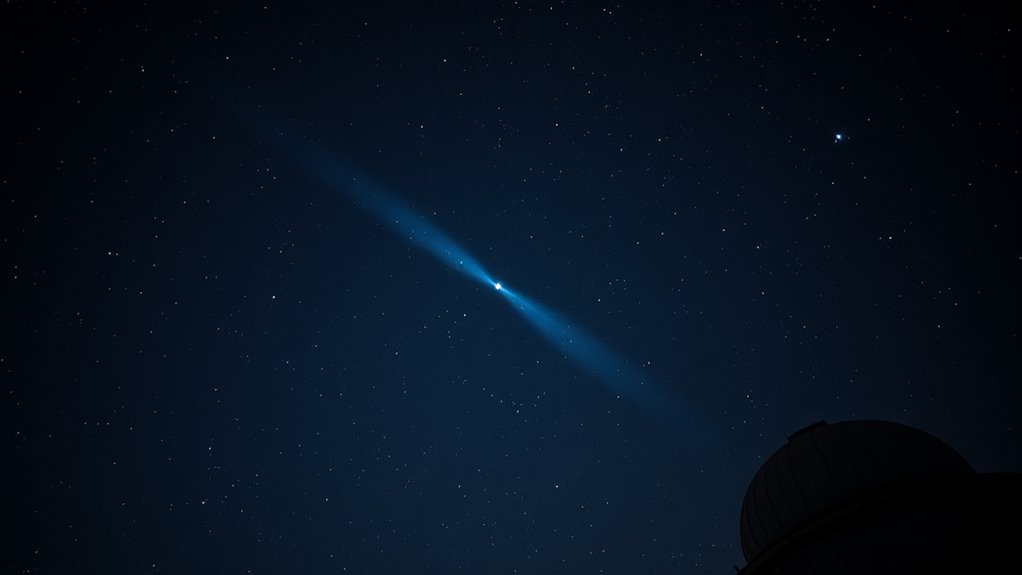Scientists are intrigued by a repeating fast radio burst that follows a precise cycle, which challenges current ideas about these cosmic events. The periodicity suggests the involvement of intense magnetic fields from neutron stars, where magnetic reconnections or interactions with surrounding material may cause the recurring signals. Understanding how these stable cycles form could unleash new insights into extreme magnetic environments. If you’re curious about what this means for our universe, there’s more to discover ahead.
Key Takeaways
- Some repeating FRBs exhibit highly regular, precise cycles, challenging existing models of random burst activity.
- Magnetic reconnection in neutron stars is a leading hypothesis for causing periodic radio bursts.
- The stability and evolution of neutron star magnetic fields influence the predictability of FRB cycles.
- Interaction with surrounding material, such as companions or accretion disks, may establish or modulate the cycle timing.
- Understanding these precise periodicities could reveal the underlying physical mechanisms of neutron star magnetospheres.

Have you ever wondered what causes some cosmic signals to repeat while others remain one-offs? Scientists are increasingly intrigued by this mystery, especially when it comes to repeating fast radio bursts (FRBs). These intense flashes of radio waves originate from distant galaxies, yet some of them occur repeatedly on regular or semi-regular intervals. Understanding why certain FRBs follow precise cycles could reveal new insights into the extreme environments where they originate. One leading hypothesis involves neutron stars, incredibly dense remnants of massive stars that have exploded as supernovae. These neutron stars possess intense magnetic fields, which play a essential role in shaping their behavior and, potentially, the repeating FRBs associated with them.
Magnetic fields are essential in explaining the cyclic nature of some FRBs. Neutron stars can generate magnetic fields trillions of times stronger than Earth’s, and these fields influence their magnetospheres and emission processes. In some models, the magnetic activity of a neutron star might periodically trigger bursts of radio waves. Think of the neutron star as a cosmic lighthouse, with its magnetic field lines twisting and reconnecting over time. When these magnetic reconnections happen in a controlled, cyclical manner, they could produce the consistent timing observed in certain repeating FRBs. Alternatively, the neutron star’s magnetic field might interact with surrounding material, such as an accretion disk or companion object, leading to periodic bursts. The magnetic field’s strength and configuration could act as a clock, resetting and releasing energy at regular intervals. Additionally, the stability of a neutron star’s magnetic field over time is crucial for maintaining such regular cycles, as magnetic field stability influences the predictability of the bursts. Moreover, recent studies suggest that magnetic evolution in neutron stars could also affect the timing and intensity of the bursts, adding another layer of complexity to these cosmic phenomena.
Magnetic fields in neutron stars may trigger periodic bursts, acting as cosmic clocks for repeating fast radio bursts.
Astronomers are exploring whether the neutron star’s rotation plays into this cycle. As the star spins, its magnetic poles sweep through space, creating beams of radio emission. If a neutron star’s magnetic field configuration is stable and the emission regions are fixed, the observed bursts could align with the star’s rotation period or some harmonic thereof. This would explain the precise periodicity seen in some repeating FRBs. Additionally, the magnetic field might influence the environment around the neutron star, controlling how and when the bursts escape into space.
While the exact mechanism remains uncertain, the connection between magnetic fields and neutron stars offers a promising avenue. These cosmic powerhouses could be the engines behind the recurring signals we observe. The periodicity hints at an underlying, stable process—possibly magnetic cycles or rotational modulation—that produces these bursts on a predictable schedule. Deciphering this pattern could reveal not just how FRBs repeat, but also shed light on the extreme physics governing neutron stars and their magnetic environments. As research advances, the precise role of magnetic fields in these phenomena continues to fascinate and challenge astronomers worldwide.
Frequently Asked Questions
Could Repeating Fast Radio Bursts Originate From Extraterrestrial Intelligence?
You wonder if repeating fast radio bursts could be alien signals, hinting at cosmic engineering. While some think these bursts might be evidence of advanced extraterrestrial technology, there’s no concrete proof yet. You should consider natural explanations, but it’s exciting to imagine that such precise signals could be deliberate communication from alien civilizations. Keep observing; future discoveries might reveal whether these signals truly originate from intelligent extraterrestrial sources.
What Are the Leading Theories Explaining the Precise Cycle?
Imagine a lighthouse beam sweeping in perfect intervals—that’s how astronomers see the precise cycle of some fast radio bursts. Leading theories suggest a neutron star with a strong magnetic field, possibly interacting with its environment or companion, causes this regularity. The neutron star’s magnetic field could be shaping emission timing, creating a stable, repeating pattern that puzzles scientists trying to uncover its mysterious origin.
How Do Repeating Bursts Differ From Non-Repeating Ones?
You notice that repeating bursts differ from non-repeating ones in their astrophysical phenomena. Repeating signals show consistent patterns, making signal analysis easier and hinting at possible underlying mechanisms like neutron stars or magnetars. Non-repeating bursts are more sporadic, complicating analysis and suggesting different origins. This distinction helps astronomers understand the nature of these mysterious signals, revealing insights into extreme cosmic environments and the processes driving these energetic events.
Are There Any Ongoing Efforts to Predict Future Bursts?
You might be surprised to learn that scientists are actively working on predicting fast radio bursts using advanced predictive modeling and ongoing astronomical monitoring. With over 100 detected bursts, researchers aim to identify patterns and potential cycles, especially for repeating sources. These efforts help improve understanding and forecasting, making it possible to anticipate future bursts. Your curiosity drives advancements that could uncover the mysteries behind these elusive cosmic signals.
What Technological Advancements Are Needed to Study These Bursts Better?
To study these bursts better, you’ll need advanced telescopic arrays capable of capturing high-resolution, real-time data. These arrays enable you to detect faint signals and analyze them instantly. Additionally, implementing sophisticated real-time data analysis tools allows you to quickly identify patterns and predict future bursts. Together, these technological advancements will deepen your understanding of the mechanisms behind fast radio bursts and improve your ability to forecast their occurrence.
Conclusion
As you gaze into the night sky, imagine these cosmic whispers echoing with perfect precision, like a lighthouse beam slicing through darkness. This repeating fast radio burst on a precise cycle feels almost like a heartbeat of the universe, steady and unyielding. It leaves you pondering the mysteries hidden among the stars, inspiring awe and curiosity. As you watch the cosmos, you realize that even in chaos, there’s a rhythm waiting to be uncovered.









